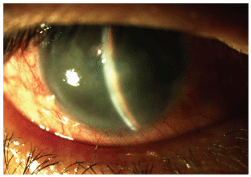 Weve had to clarify this issue for many patients, and its a question that weve fielded from colleagues at numerous conferences as well: Is it OK to use over-the-counter cold remedies in glaucoma patients? A quick trip to the medicine cabinet confirms the dilemma; printed right there on the bottle of cough syrup is a warning very similar to this one. Ask a doctor before use if you have:
Weve had to clarify this issue for many patients, and its a question that weve fielded from colleagues at numerous conferences as well: Is it OK to use over-the-counter cold remedies in glaucoma patients? A quick trip to the medicine cabinet confirms the dilemma; printed right there on the bottle of cough syrup is a warning very similar to this one. Ask a doctor before use if you have:
Heart disease.
High blood pressure.
Thyroid disease.
Diabetes.
Trouble urinating due to an enlarged prostate gland.
A breathing problem, such as emphysema or chronic bronchitis.
Glaucoma.
This month, well examine the issue of OTC medications and their potential contraindications in individuals with glaucoma.
Systemic Drugs Ocular Effects
Systemic medications have the capacity to impact ocular structure and function in many ways. A number of prescription drugs are well known for their potential retinal toxicity, including Plaquenil (hydroxychloroquine, Sanofi Aventis), tamoxifen and thioridazine.1 Vortex keratopathy has been linked to use of amiodarone and indomethacin.2 Anti-anxiety medications, such as Prozac (fluoxetine, Eli Lilly) and Zoloft (sertraline, Pfizer), can cause blurred vision and dry eye.3 And, of course, corticosteroids are notorious for their capacity to raise intraocular pressure (IOP) and promote cataract formation.4 Fortunately, we can monitor patients better when they use prescription medications, which are typically included in their medical records, and we can intercede if we see a potential complication with a condition, such as glaucoma.
We often dont get this opportunity, however, when patients use OTC medications. Patients often think that OTC medications are somehow safer than those requiring a prescription.
In fact, over-the-counter products can have substantial ocular risks and contraindications. Confounding the problem is the fact that the packaging verbiage on OTC products is often vague and misleading. Virtually all cold products carry a warning regarding glaucoma. But, by what mechanisms do these products influence IOP or glaucoma progression?
Do patients with closed angles, such as this one, have to worry about the side effects of their OTC cold medications?
The key ingredients in most OTC cold remedies include an antihistamine (e.g., diphenhydramine, chlorpheniramine or loratadine) and a sinus decongestant (e.g., pseudoephedrine or phenylephrine). Antihistamines, because of their inherent anticholinergic properties, have the capacity to induce pupil dilation via parasympathetic blockade of the iris sphincter muscle. Likewise, decongestants have sympathomimetic properties. As derivatives of epinephrine, these drugs can induce pupillary mydriasis by directly stimulating the iris dilator muscle.

Historically, pupillary mydriasis has been seen as a provocative test for glaucoma and a potentiator of ocular hypertension, because dilation of the pupil results in thickening of the peripheral iris and exposes a greater surface area of the crystalline lens to the anterior chamber.5 In eyes with shallow chambers, such alterations to these anatomical structures can induce an angle closure episode via iridotrabecular adhesion, pupillary block or a combination of these mechanisms.
Intuitively, most practitioners realize that dilating the pupil can pose a risk for those with a narrow anterior chamber. So, we sometimes forego pharmacologic dilation in patients deemed to have occludable angles until prophylactic iridotomy can be performedthe very act of dilating may precipitate an angle closure event. In patients with open angle glaucoma, mydriasis can also induce a transient elevation of IOP, though reports as to the extent, duration and severity of such phenomena vary widely in the literature. While some studies imply a strong propensity for significant IOP rise in open-angle glaucoma, others have found an essentially normal distribution of post-dilation IOP in the same population.6-9
Antihistamines and Angles
The ability for certain systemic drugs to elevate IOP via induced mydriasis has been extensively documented.1,3,10-13 However, the extent and magnitude of any potential response would be predictably greater for topically administered agents than virtually any systemic drug. In the case of OTC cold medications, several noted glaucoma experts agree that the vast majority of glaucoma patients can use these products without fear of any complication whatsoever.
For instance, in a recent online interview, Richard P. Wilson, M.D., of
Elliot B. Werner, M.D., a noted glaucoma specialist and a former consulting ophthalmologist at the Pennsylvania College of Optometry at
To Treat or Not to Treat
Most glaucoma patients are at low risk of any adverse event related to their OTC cold medicine. Patients with anatomically narrow angles or angle closure glaucoma who have not received definitive treatment (i.e., laser or surgical iridectomy) are at greatest risk, and should be advised to avoid these agents whenever possible.
Those with plateau iris syndrome should also avoid these medications. Patients who have been successfully treated for angle closure via surgical intervention are at minimal risk. Generally, open-angle glaucoma patients, who account for approximately 90% of glaucoma cases seen clinically, are also not in any great danger from the use of OTC cold remedies; however, a very small percentage may demonstrate a substantial spike in IOP when using these agents.
The most significant risk factors that predict IOP elevation secondary to mydriasis in open-angle glaucoma patients are pigmentary dispersion and treatment with miotics (e.g., pilocarpine).6 We must consider the cost-to-benefit ratio of this very small risk when confronted by a patient suffering terribly with a bad cold and the symptomatic relief that OTC medications can impart.
But, advise patients with end-stage glaucoma and fragile optic nerves to exercise caution with OTC drugs. If there is any question whether a particular open-angle glaucoma patient may respond unfavorably, perform in-office measurements of pre- and post-dilation IOP. This simple technique can offer some predictive value in determining whether over-the-counter cold remedies might be harmful.
1. Li J, Tripathi RC, Tripathi BJ. Drug-induced ocular disorders. Drug Saf 2008;31(2):127-41.
2. Hollander DA, Aldave AJ. Drug-induced corneal complications. Curr Opin Ophthalmol 2004 Dec;15(6):541-8.
3. Jaanus SD. Ocular side effects of selected systemic drugs. Optom Clin 1992;2(4):73-96.
4. Carnahan MC, Goldstein DA. Ocular complications of topical, peri-ocular, and systemic corticosteroids. Curr Opin Ophthalmol 2000 Dec;11(6):478-83.
5. Lowe RF. Primary angle-closure glaucoma. A review of provocative tests. Br J Ophthalmol. 1967 Nov;51(11):727-32.
6. Shaw BR, Lewis RA. Intraocular pressure elevation after pupillary dilation in open angle glaucoma. Arch Ophthalmol 1986 Aug;104(8):1185-8.
7. Marchini G, Babighian S, Tosi R, et al. Comparative study of the effects of 2% ibopamine, 10% phenylephrine, and 1% tropicamide on the anterior segment. Invest Ophthalmol Vis Sci 2003 Jan;44(1):281-9.
8. Velasco Cabrera J, Eiroa Mozos P, Garcia Sanchez J, Bermudez Rodriguez F. Changes in intraocular pressure due to cycloplegia. CLAO J 1998 Apr;24(2):111-4.
9. Hancox J, Murdoch I, Parmar D. Changes in intraocular pressure following diagnostic mydriasis with cyclopentolate 1%. Eye 2002 Sep;16(5):562-6.
10. Lachkar Y, Bouassida W. Drug-induced acute angle closure glaucoma. Curr Opin Ophthalmol 2007 Mar;18(2):129-33.
11. Clarificationdrug risk in patients with glaucoma. Med Lett Drugs Ther 2001 Jun 11;43(1106):52.
12. Tripathi RC, Tripathi BJ, Haggerty C. Drug-induced glaucomas: mechanism and management. Drug Saf 2003;26(11):749-67.
13. Khan MA, Watt LL, Hugkulstone CE. Bilateral acute angle-closure glaucoma after use of Fenox nasal drops. Eye 2002 Sep;16(5):662-3.
14. Devine N. Glaucoma and non-glaucoma medications. Glaucoma Service Foundation to Prevent Blindness. Available at: www.willsglaucoma.org/supportgroup/20041208.php (Accessed October 29, 2008).
15. Devine N. Glaucoma and OTC (over-the-counter) medications. Glaucoma Service Foundation to Prevent Blindness. Available at: www.willsglaucoma.org/supportgroup/ 20020731.php (Accessed October 29, 2008).

